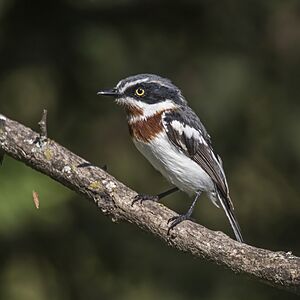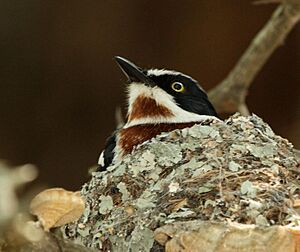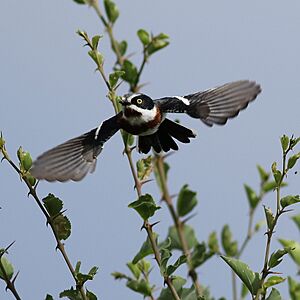Chinspot batis facts for kids
Quick facts for kids Chinspot batis |
|
|---|---|
 |
|
| Male in South Africa | |
 |
|
| Female in Zimbabwe | |
| Conservation status | |
| Scientific classification | |
| Genus: |
Batis
|
| Species: |
molitor
|
The chinspot batis (scientific name: Batis molitor) is a small, active songbird. It belongs to the Batis family. You can find these birds in woodlands across southern Africa. They live from the Eastern Cape all the way up to southern Kenya and Gabon. The chinspot batis is a common bird in these areas.
Contents
What Does a Chinspot Batis Look Like?
The chinspot batis is a small, sturdy bird. It is about 12 to 13 centimeters (5 inches) long. It has a black mask across its face. There is a short white stripe above its eye. Its head is grey, and its throat is white.
The top part of its body is grey. It has a clear white stripe on its wings. Its eyes are yellow, and its legs and beak are black.
How to Tell Males and Females Apart
Male chinspot batises have a black band across their chest. Females have a reddish-brown (chestnut) band. Females also have a reddish-brown spot on their throat. Young birds look a lot like females. However, their chest band and throat spot are a lighter, yellowish-brown color.
Where Do Chinspot Batises Live?
You can find chinspot batises in many countries in Africa. These include Angola, Botswana, Burundi, and the Republic of the Congo. They also live in the DRC, Eswatini, Gabon, Kenya, Lesotho, and Malawi. Other places they call home are Mozambique, Namibia, Rwanda, South Africa, South Sudan, Tanzania, Uganda, Zambia, and Zimbabwe.
Chinspot Batis Behavior and Habits
Chinspot batises are usually seen alone or in pairs. They are very active birds. They constantly move their heads, looking for food. They also flick their tails and wings. Their bodies jerk, and they cock their heads.
Social Gatherings and Territorial Displays
During the cooler months, they sometimes form groups called "parliaments." These groups can have up to ten birds. Often, all the birds in a parliament are the same sex. In these groups, they show off by flicking their wings. This makes a noise called "wing-fripping." They also call to each other and sometimes even fight.
Chinspot batises defend their territory all year round. A male will sing a three-note whistle from a high spot. This song tells other birds that this area is his. The female might join him in a duet. When they call, they hold their head up. This shows off their white throat.
If they are very serious about defending their territory, the male will fly in circles. He flies in a jerky way above the trees. His feathers on his back will puff out. He holds his head up and makes frog-like calls. He also whistles and frips his wings. They can be aggressive towards predators, like owls.
What Do Chinspot Batises Eat?
These birds mostly find their food in trees. They either catch insects in the air (hawking) or pick them off leaves (gleaning). Most of their food is caught within the tree branches. Sometimes, they fly like a flycatcher to catch insects in the air. They rarely catch food on the ground.
When they catch prey, you can hear their beak snap shut. They hold the food down with one foot. Then, they strip off parts they don't want. Larger prey might be beaten against a branch. Their diet is mainly insects and their larvae. They also eat spiders.
How Chinspot Batises Raise Their Young
The chinspot batis builds a small, cup-shaped nest. It is made from plant fibers and spider webs. They decorate the outside with lichen. Both the male and female build the nest on a flat tree branch.
The female lays one to four eggs. She sits on the eggs for 16 to 18 days. Both parents feed the young birds.
Nesting Habits and Chick Care
A study in Eswatini looked at how chinspot batises breed. They found that nests were often built in thorny bushes or trees. This helps protect the nest. Eggs were laid between late September and early January. November was the busiest time for laying eggs.
On average, about 0.65 young birds successfully left the nest per pair each year. Usually, pairs only had one group of chicks per year. However, if their first nest failed, they would build a new one.
The adult birds mainly ate caterpillars and moths. They fed these same insects to their young. The study also showed that older chicks were fed more often than younger ones. But once the young birds left the nest, the younger ones were fed more than the older ones.
Where Do Chinspot Batises Live?
Chinspot batises live in Savanna woodlands. These woodlands often lose their leaves in the dry season. They can be found in areas with Brachystegia trees, river thickets, and scrubland. You might also see them in places where people live. This includes orchards, farms, gardens, and parks.
In the mountains of central Africa, they can live as high as 3,000 meters (about 9,800 feet). In the northern parts of their range, they are more specific about their habitat. This is because there are more types of batises there, so they have more competition.
Chinspot Batis Family Tree
The chinspot batis is part of a "superspecies." This means it is closely related to other similar batis birds. In southern Africa, other birds in this group include the pririt batis, Woodwards's batis, pale batis, and Cape batis.
Woodwards's and Cape batises live in forests. The chinspot batis lives in woodlands. The pririt batis lives in dry woodlands to the west. The pale batis lives in humid coastal woodlands to the east.
Types of Chinspot Batises
There are four recognized types, or subspecies, of the chinspot batis:
- B. m. pintoi
- Found from southeastern Gabon to Angola, southwestern Zaire, and northwestern Zambia.
- B. m. puella
- Found from eastern Zaire to Uganda, western Kenya, and western Tanzania.
- B. m. palliditergum
- Found from southern Zaire to Namibia, Botswana, Malawi, and northwestern South Africa.
- B. m. molitor
- Found from southern Mozambique to eastern South Africa.




